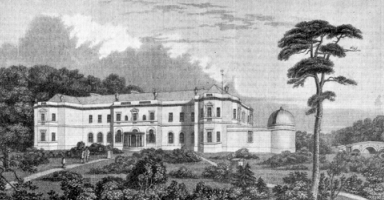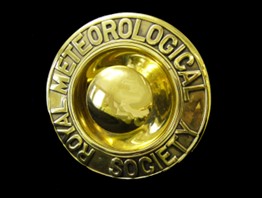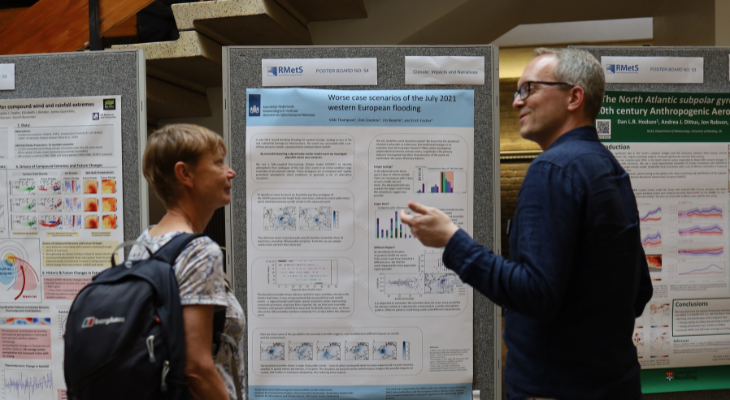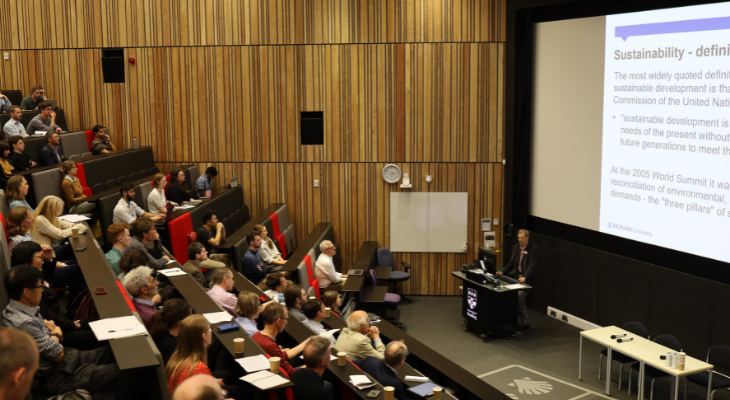History of the Society
On 3 April 1850, ten gentlemen assembled in the library of Hartwell House, near Aylesbury. According to the minutes of the meeting, they gathered "to form a society, the objects of which should be the advancement and extension of meteorological science by determining the laws of climate and of meteorological phenomena in general".
They called the society the British Meteorological Society and appointed as its first President Samuel Charles Whitbread, a grandson of the founder of the famous brewing firm. The society they formed still exists and flourishes as the Royal Meteorological Society. It became The Meteorological Society in 1866, when it was incorporated by Royal Charter, and the Royal Meteorological Society in 1883, when Her Majesty Queen Victoria granted the privilege of adding 'Royal' to the title.
Besides Samuel Whitbread, those present at the meeting on 3 April 1850 were Dr John Lee, the owner of Hartwell House, the Reverend Samuel King of Latimer, near Chesham, the Reverend Joseph Bancroft Reade of Stone Vicarage, near Aylesbury, the Reverend Charles Lowndes of Hartwell Rectory, James Glaisher, Superintendent of the Magnetic and Meteorological Department of the Royal Observatory at Greenwich, Edward Joseph Lowe of Highfield House, near Nottingham, Vincent Fasel of Stone, near Aylesbury, John Drew of Southampton and William Rutter of Haverstock Hill, north-west London. James Glaisher was appointed Honorary Secretary and John Lee Honorary Treasurer.

(3 April 1850, Hartwell House, near Aylesbury)
Society’s Headquarters
For many years, the Society rented rooms as office space. In early 1852, then as the British Meteorological Society, the Society rented rooms at 5 Cavendish Square, London. Before that it was administered from the homes of John Lee and James Glaisher. In 1857, the Society moved to Great George Street, London, SW, renting various rooms at No. 25 (1857 to 1872), No. 30 (1872 to 1891), and finally No. 22 (1891 to 1898).
From 1898 to 1921, the Society rented rooms in a building at Prince's Mansion, 70 Victoria Street, London, SW. In 1921, the Society bought its first property and moved to 49 Cromwell Road, South Kensington, London, SW7.

The property at 49 Cromwell Road was sold in 1971 and the Society moved to temporary accommodation in an old bank on Bracknell High Street in June that year, which it named Cromwell House. In the meantime, it commissioned an architect-designed building in Grenville Place, Bracknell. This was named James Glaisher House. The Society remained there for 19 years until April 1990 when it moved to its current headquarters at 104 Oxford Road, Reading, where it remains today. The Society’s current premises at Oxford Road is a 250-year-old listed building called Mannson House.
Membership Growth
By the end of 1850, the membership of the new society was 145, including those transferring from the Meteorological Society of London. Numbers rose steadily to 200 in 1856, and to 300 by 1864. Interestingly, neither the award of the Royal Charter nor the addition of Royal to our name produced an increase in the membership numbers, and by 1880 there were still about 500 members. By the Society’s golden jubilee in 1900 these had grown to 600 for the first time.
By the end of 1900 only one of the founding members was still alive - James Glaisher. Numbers continued to grow, reaching 700 in 1907, 800 in 1919 and 900 in 1921 following the amalgamation with the Scottish Meteorological Society.
Membership topped 1,000 for the first time in 1944. The increase during the war years was aided by the heightened interest in meteorology among those who served in the RAF. The increase was also partly due to the efforts of Professor Gordon Manley (President 1945-46) who urged Council to encourage meetings of a popular nature and to increase the number of meetings outside London. He also helped to launch the Society’s journal Weather in May 1946. By 1947 numbers had soared to over 1,700 and, boosted by the Society’s centenary in 1950, numbers climbed to 2,000 for the first time in 1953.
The Canadian branch of the Society was dissolved at the end of 1966 to be replaced by the Canadian Meteorological Society, and likewise the Australian branch was dissolved at the end of 1988. Both events caused a temporary decrease in membership, but even so membership continued to flourish in the UK, with numbers topping 3,000 in 1991. By the end of the millennium the Society boasted a membership of over 3,600.
The split in membership category is approximately one third academic, one third professional practitioner and one third amateur enthusiast. In 2011 the Society abolished School Membership, which had very much become a barrier to wider schools’ engagement. This had a positive effect in making the Society’s education resources available free to all schools. We have also seen an upturn in the number of schools who are on the Society contact list, with over 1,000 teachers signed up to receive regular bulletins.
The Society Archive
The Society's archive is located in Exeter, in the National Meteorological Archive, at the Met Office.
The archive holds rare books, personal papers of notable meteorologists and old meteorological photographs as well as Council and committee papers.
The originals of the Beaufort Wind and Weather Scales are also owned by the Society, and cared for by the team at the National Meteorological Archives https://www.metoffice.gov.uk/research/library-and-archive/
The Society has a dedicated Special Interest History Group. If you would like to learn more about the history of the Society along with the history of meteorology in general, please contact the History Group.
Society’s Scientific Journals

From the beginning, the Society published Annual Reports of the British Meteorological Society (1851-1860) which included scientific papers, including James Glaisher’s illustrations of snowflakes. From 1860 to 1871 this became Proceedings of the Meteorological Society, also publishing scientific papers, and was the forerunner of The Quarterly Journal (QJ).
In 1873, the Society published its first issue of The Quarterly Journal of the Royal Meteorological Society, which remains the Society’s flagship journal to this day. It was originally called the Bibliography of Meteorological Literature from 1871 and given its current name in 1873. The QJ was first edited by James Glaisher, who also wrote the first article on the direction of the wind at the Royal Observatory, Greenwich. The journal continued to be published quarterly up until 1987 (other than the period 1945-1948, when paper shortages limited this to two or three issues per year). From 1988 this was increased to six issues per year, and from 1995 to eight issues as it is today. Despite this, it retains the title ‘Quarterly’ Journal.
In 1925, Council decided that the QJ was becoming too technical and began publishing the Memoirs of the Royal Meteorological Society (1926 to 1939) which carried the more technical papers, leaving the easier papers to be published in QJ. Forty papers were published in the Memoirs during this period, including many ‘classic’ meteorological papers of the time.
The next publication launched by the Society was its monthly magazine Weather in May 1946. This was a more ‘popular’ publication designed to appeal to amateur and professional meteorologists alike and has been issued free to members ever since. In his foreword to the first issue, Gordon Manley said “It is hoped with the aid of this magazine to reach not only the many Fellows who have expressed a desire for comments on current events, but also the wider public which nowadays increasingly demands some subject of universal interest as a recreation for the mind. Foreigners have often pointed out that in Britain no subject fulfils this requirement better than the weather, whose vicissitudes are always with us to give us food for thought.”
Weather has always provided monthly weather statistics, which evolved into the popular centre-piece called Weather Log. In 2004, Weather was enlarged to its current A4 format to coincide with the ‘re-branding’ of the Society with the sunburst logo.

The next Society journal to be launched was the Journal of Climatology, published by John Wiley & Sons in 1981. Both the Society and the publisher were considering a publication to fulfil the needs of climatologists and joined forces to launch this journal. In 1989 the journal changed its name to the International Journal of Climatology to reflect the worldwide nature of the science.
Meteorological Applications was launched by the Society in 1994, published by Cambridge University Press until being transferred to Wiley-Blackwell. As Bob Riddaway said in the editorial for the first issue “The aim of Meteorological Applications is to serve the needs of all applied meteorologists, forecasters and users of meteorological services.” Met Apps, as it’s known, was very much seen as a replacement for the discontinued Meteorological Magazine, published by the Met Office. This was a subscription journal until January 2020 when it moved to be a fully Open Access journal.
In 2000, the Society launched its first online-only journal, Atmospheric Science Letters (more commonly known as ASL). It was published at first by Academic Press, then Harcourt and Elsevier due to a series of takeovers, and now by Wiley as with all our journals. Although the articles are fully peer reviewed as other journals, the aim of ASL is to provide fast-track publishing of shorter articles. This was a subscription journal until January 2016 when it moved to be a fully Open Access journal.
In 2008 the Society launched two new publishing initiatives, a new journal partnership between the Society, the Royal Geographical Society and Wiley-Blackwell – the WIREs Climate Change Journal, under the editorship of Mike Hulme, and an academic book programme, also in partnership with Wiley.
In 2012 launched of the new partner journal (again with Wiley, but also this time including the NERC data centres) - the Geoscience Data Journal (GDJ). GDJ is the Society’s second online only journal, the first fully Open Access journal, and publishes papers that related to datasets deposited in recognised global data centres. The Editorial Board already has representatives from the UK and US data centres and this is being extended further to European and Australian data centres.
Climate Resilience and Sustainability (CRS), an interdisciplinary open-access journal studying the broad subject of understanding the implications of climate change for a sustainable environment and society, was launched in 2020. The journal acts as a forum for researchers and practitioners who are using the best weather and climate information available to propose policies and actions that are climate resilient and deliver sustainable outcomes.
Society Meetings and Conferences
The Society has held many free public meetings, mainly in London, but occasionally elsewhere, ever since the outset in 1850 to further the dissemination of meteorology and related sciences. These have been well attended and popular, using invited speakers, and now take place about ten times a year. In the early 2000s most were held at the conference facilities at London Zoo, and prior to that we used Imperial College London (ICL) for many years. In June 2008 the Society moved back to ICL for about half of its National Meetings, with the other meetings being hosted at other meteorological centres in the UK. The COVID pandemic moved all Society meetings online, and since the Society has settled on a balance of in-person and online meetings.
The Society has also hosted major conferences. The first such ‘National’ conference was held at the University of Reading (UoR) in 1998. In 2000, we held a special conference in Cambridge to celebrate our 150th anniversary. The second of the ‘National’ conferences was held at UMIST in Manchester in 2001. The third main conference, billed as an ‘International Conference’, was held at the University of East Anglia (UEA) in Norwich in 2003 and the fourth at Exeter University in 2005. Conferences continued to be held biennially at Heriot-Watt University in Edinburgh in 2007, at UoR in 2009, and at the University of Exeter in 2011. In 2013 the Society did not organise its own conference but instead hosted the European Meteorological Society Conference, which took place at the UoR. During this event the Society also hosted a meeting of the International Forum of Meteorological Societies (IFMS), which is a member organisation made up of the met societies around the world who meet every two years to share best practice and capacity building initiatives.

The Society jointly ran annual in-person conferences with NCAS from 2016 until the pandemic led to a restructuring of the conference until 2022.
The Society now hosts the annual weather and climate conference, and has done so since 2024.
At the UEA conference in 2003, meteorological students held their own conference during the weekend prior to the main conference. The ‘Students Assembly’ was such a success that this has been repeated annually ever since and is now a fully blown Student Conference organised and run by the students themselves.
During main conference years this is held at the same location during the weekend or days prior to the main conference. In years when there has been no main conference, they have been held at Leeds University in 2004, UEA in 2006, University of Manchester in 2008, and in 2010 it was held at the Met Office in Exeter, including Met Office early-career scientists for the first time.

In 2011 the Student Conference was back in Exeter but this time at the University, and in 2012 the students returned to the University of Leeds. In 2013 the Student Conference preceded the European Meteorological Society Conference at the University of Reading. In 2014 the conference was held at the Manchester Museum and in 2015 at the University of Birmingham. In 2016, the Student Conference again preceded the main conference at the University of Manchester. The conference was renamed the Student and Early Career Scientist Conference and was held at the Met Office in Exeter in 2017, at the University of York in 2018 and at the University of Birmingham in 2019. In 2020, due to the COVID pandemic, the Society ran a virtual conference. In-person conferences resumed in 2022 with the Student and Early Career Scientist Conference taking place at the University of Manchester. In 2023, the conference was renamed Early Career Scientist and Student Conference to recognise the growing number of ECRs attending and was held at UoR in July 2023 and the Met Office in 2024.
The Society has also hosted Amateur Meteorologists’ Conferences held at the University of Reading in 2010, 2013 and 2016. In 2017 the conference was renamed WeatherLive and shortened to one-day event. It has also changed venue, taking place in central London in 2017 and BAS, Cambridge in 2018 and again in London in 2019. WeatherLive was hosted virtually between 2020 and 2022 due to the pandemic restrictions. In 2023, WeatherLive was a joint virtual event with the RNLI and, although no longer called WeatherLive, the Society aims to co-hosted annual events for amateur meteorologists.
RMetS Past Presidents:
Without the dedication and leadership of many distinguished meteorologists and other scientists, the Society would not have survived for over a century and a half. The following is a list of those who have served the Society as President.
Education and Outreach
The Society’s education activities have been increasing steadily and successfully over the last few decades; it is the largest charitable programme of work of the Society (the largest activity of the Society is its journal publishing programme, although this returns a profit that is used to fund the Society’s charitable work). The first flagship education project was the MetLink International school participation project, started in 1998. From the 12 participants in that year, it grew to around 250 in 2005, and in 2008 the project was closed due to lack of participation. However, the Society continued with the MetLink website, transforming it into a resource area for both primary and secondary schools and teachers.
The latest version of the MetLink website was launched in 2022 allowing teachers to find their curriculum-relevant classroom and support materials more easily. In association with this, the Society maintains a database of teachers, now with well over 2,000 members, who receive half termly updates about new resources and other relevant Society activities.
In 2011 the Society launched a new initiative to give subject knowledge training to trainee geography teachers through their universities. This was aimed at up-skilling new teachers to have greater confidence to teach weather and climate in secondary schools, particularly in light of changes to the National Curriculum and exam specifications which, for the first time in a couple of decades, make weather teaching compulsory. As the platforms for teacher training change, the Society has looked for new ways to reach both trainee and established teachers, particularly adapting to online teaching during COVID. In 2016, the content of the PGCE training material was rewritten to form the basis of a Massive Open Online Course (FutureLearn) entitled ‘Come Rain or Shine – Understanding the Weather’ open to all but specifically marketed at UK geography teachers. Over 40,000 people have registered for the 3 week course so far .

The Society fruitfully collaborated with NCAS and the Royal Geographical Society (RGS) to produce three booklets aimed at secondary teachers (secondary science, secondary geography and more specifically A-Level geography) based on the 2014 IPCC reports. In 2021, these were superseded by new resources based on the AR6 reports produced in collaboration with the Royal Geographical Society.
In 2021, the Society developed a Weather and Climate Teachers’ Guide for secondary geography teachers. Consisting of a hard-copy booklet, which was distributed free of charge to thousands of schools across the UK, and corresponding online classroom and CPD resources, it has won several awards and continues to be extended and reviewed.
Building on the increase in demand for high quality climate change education in schools, in 2022 the Society initiated an annual survey of the climate literacy of school leavers. In association with this, members and other climate change experts contributed to a review of all current GCSE specifications in England, with a view to improving the support for teachers of all subjects to integrate climate change into their lessons.
The Society is increasingly developing a wider general public and Government policy engagement programme. During 2007 the Society held two public engagement events, six policy consultations and gave evidence to the Science and Technology Select Committee. In 2008, we again participated in an important programme of consultations in particular the Climate Change Bill and played an active part in the work of the Voice of Young Science (VoYS). In 2012 the Society gave evidence to the Science and Technology Select Committee on the Met Office and the state of meteorological science in the UK. In 2013 and 2014 the Society was heavily involved in responding to Government, examination board and subject association reviews of the new National Curriculum, GCSE and A-Level specifications, and has ongoing interaction with the 5 GCSE/ A-Level awarding bodies in the UK to guide the meteorological content in the specification and supporting materials for teachers. In 2014 the Society gave evidence to the Science and Technology Select Committee on the IPCC AR5 process, and in 2016 gave evidence after EU referendum results on opportunities and risks for UK science post-Brexit. The Society works closely with the Department for Education, with growing links with the Scottish government and partners with others on government funded educational projects.
In the past, the Society has supported the UK’s main public science festivals, as well as the OPAL (Open Air Laboratories) roadshow on meteorology, and BBC Learning summer roadshows and its own festival on Weather, Arts and Music (WAMFest), based in Reading, with a programme of science, art, music and dance in 2012. In 2015, the Society became the academic partner for the BBC as part of the BBC Weather Watchers project.
In 2008 the Society worked with the Open University to establish a foundation course in ‘Understanding the Weather’ which subsequently formed the basis of other weather-related short courses. These were popular courses and have been extremely beneficial to the Society in attracting those taking the course to become Society members. In 2016, this was replaced with the FutureLearn course entitled ‘Come Rain or Shine – Understanding the Weather’, which still exists today.
Professional Accreditation in Meteorology
Professional accreditation is an increasingly important part of the work of the Society. There are a number of ways in which the Society provides support and accreditation for those seeking meteorological qualifications.
The Society launched the Chartered Meteorologist (CMet) qualification in 1994 which entitles qualified Fellows to use CMet after their name. In 2014 the Society successfully launched the Registered Meteorologist (RMet) qualification which is accessible to a broad cross section of the professional meteorological community and complements and underpins the CMet qualification. The RMet provided an important stepping stone in the Society’s Qualifications Framework. As the schemes are progressive then typically new entrants to the profession might aspire to RMet and then progress to CMet at a later stage. In addition, individuals are expected to continue enhancing their knowledge and skills by participating in Continuous Professional Development (CPD) throughout their careers. In 2014 the Society launched ACCSYS, an online tool for accreditation applications and CPD records and is available to all members. In 2016, the CMet was refreshed to bring the application and renewal processes in line with the RMet. The professional accreditation schemes are overseen the Accreditation Board.
The Society played a central role in the development of an NVQ/SVQ vocational (work-based) qualification in meteorology, launched in 2002. These were replaced by a series of several new qualifications framed within the new national Qualifications and Curriculum Framework (the QCF) and then renamed the Regulated Qualifications Framework (RQF). These qualifications required assessment centres and had three centres in the UK (the Met Office, the Royal Navy, and MeteoGroup) until 2021 when all three centres became dormant.
As well as accrediting people, the Society also recognises university courses which meet the WMO BIP-M requirements.
Find out more about the Society’s accreditation schemes
Bursaries and Legacy Funds
The Society uses its Legacies Fund, Carer’s Fund, Discretionary Fund, and Rupert Ford Fund (the latter of which it administers on behalf of the Ford family) to provide support to meteorologists for a range of activities, including attending meetings and conferences.
Society Awards
The Society also recognises and rewards excellence, through its medals and awards, to people and teams who have made outstanding and exceptional contributions to meteorology and related disciplines. The Society’s awards include the prestigious Symons Gold Medal and Mason Gold Medal, the Society’s two senior medals which are awarded in alternate years. The latter was donated by Sir John Mason in 2005. Vaisala have also endowed an industry-sponsored Society prize. This introduced new opportunities for the Society to recognise achievements in meteorological observations and data.
Over recent decades the nature and extent of contributions of Society members has broadened substantially, as meteorology and related disciplines have become more central to education, business and policy. It’s important to the Society that our awards continue to reflect the breadth of work in the meteorological community, as well as maintaining a link to more than 170 years of Society history. Therefore in 2021 the Society carried out an audit and membership survey to help us build a modernised award portfolio. A portfolio of new awards was launched in 2022.
Our basic principles of recognising and rewarding excellence to people and teams who have made outstanding and exceptional contributions to meteorology and related disciplines have not changed. Members told us that they wanted to see a broader range of awards, so new awards were added recognising innovation in use of observations and instrumentation and in use of models, computational tools and visualisation. Members told us that awards and monetary prizes for early-career achievements were particularly helpful for career development, so the Society added an early career communication award and focussed our monetary prizes on early career awards. The Society also amended the remit of some of our existing awards to make these accessible to a broader range of nominees, including co-authors and teams/collaborations.
The awards are now grouped into 4 sections based on the activities of the Society and its members: “Advancing Science”, “Educating, Inspiring and Enthusing”, “Impact on Science, Policy and Society”, and “Contribution or Service to the Society or Profession”.
International Meteorological Societies
The Society plays a key role as the custodian of both the science and the profession of meteorology in the UK and has an important role to play internationally as one of the world’s largest meteorological societies.
The Society is a founding member of the European Meteorological Society (EMS), a federation of European meteorological societies which celebrated its 25th anniversary in 2025. The Society’s Chief Executive is the current EMS President and the General Secretary is the Society’s representative on their Council.
The Society is also one of the founder members of the International Forum for Meteorological Societies (IFMS). This organisation draws together the national meteorological societies from around the world, and meets opportunistically around other international conferences and events since it was founded in 2010. The IFMS helped to form the African regional Met Society (AfMS), a federation of African meteorological societies founded in 2023.

